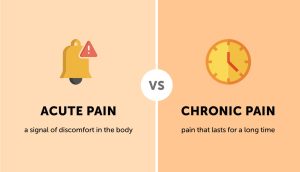Acute vs Chronic Muscle Pain: How to Tell the Difference
Muscle pain is something everyone experiences at some point, whether it’s from a tough workout, a minor injury, or a more persistent underlying issue. But how do you know if what you’re feeling is acute muscle pain or chronic muscle pain? Understanding the difference is key to choosing the right treatment and preventing further damage. In this article, we’ll break down the distinctions between acute and chronic muscle pain, their causes, symptoms, and how to manage each type effectively.
What Is Acute Muscle Pain?
Acute muscle pain is typically short-term and comes on suddenly, usually as a result of a specific event such as an injury, strain, or overuse. It is your body’s natural response to trauma or inflammation.

Common Causes of Acute Muscle Pain
- Overexertion during physical activity
- Muscle strains or sprains
- Injuries or accidents
- Minor surgeries or injections
- Infections like the flu (which can cause body aches)
Symptoms of Acute Muscle Pain
- Sudden onset of pain
- Localized soreness or tenderness
- Swelling or bruising in the affected area
- Muscle stiffness or limited range of motion
- Pain that improves over days or weeks
What Is Chronic Muscle Pain?
Chronic muscle pain, on the other hand, is long-lasting and persists for weeks, months, or even years. It may not be linked to a clear injury or cause. Often, chronic pain is a symptom of a larger medical condition or a disorder affecting the nervous system or muscles.
Common Causes of Chronic Muscle Pain
- Fibromyalgia
- Chronic fatigue syndrome
- Myofascial pain syndrome
- Autoimmune disorders (like lupus or rheumatoid arthritis)
- Chronic stress or anxiety
- Poor posture or repetitive strain
Symptoms of Chronic Muscle Pain
- Dull, aching pain that persists over time
- Widespread muscle discomfort
- Fatigue and sleep disturbances
- Sensitivity to touch or pressure
- Pain that doesn’t improve with rest or standard treatment
Key Differences Between Acute and Chronic Muscle Pain
Understanding the primary differences between these two types of muscle pain can help you identify what you’re dealing with and take the right steps for treatment.
| Feature | Acute Muscle Pain | Chronic Muscle Pain |
|---|---|---|
| Onset | Sudden | Gradual or long-lasting |
| Duration | Short-term (days to weeks) | Long-term (months to years) |
| Cause | Specific injury or event | Often unclear or related to chronic condition |
| Area Affected | Localized | Widespread or multiple areas |
| Response to Treatment | Improves with rest and care | May resist standard treatments |
When to See a Doctor for Muscle Pain
While occasional muscle pain is normal, persistent or severe symptoms may require medical attention. Here’s when to seek professional help:
- Pain lasts longer than 2 weeks
- Severe swelling or bruising
- Sudden weakness or numbness
- Fever or unexplained weight loss
- Difficulty moving or performing daily tasks
How to Treat Acute Muscle Pain
For most people, acute muscle pain improves with basic home care and rest. Try the following:
R.I.C.E Method
- Rest: Avoid activity that aggravates the muscle.
- Ice: Apply ice packs for 15-20 minutes at a time to reduce inflammation.
- Compression: Use wraps or bandages to support the area.
- Elevation: Raise the affected area to minimize swelling.
Over-the-Counter Medications
Nonsteroidal anti-inflammatory drugs (NSAIDs) like ibuprofen or naproxen can help relieve pain and reduce inflammation.
Gentle Stretching
Once the pain subsides, light stretching can help restore flexibility and prevent stiffness.
How to Manage Chronic Muscle Pain
Chronic muscle pain requires a long-term strategy that may include medical treatment, lifestyle changes, and alternative therapies.
Medical Treatments
- Prescription pain relievers or muscle relaxants
- Physical therapy to strengthen muscles and improve posture
- Trigger point injections for myofascial pain
- Sleep aids if rest is disrupted by pain
Lifestyle Changes
- Regular low-impact exercise (walking, swimming, yoga)
- Stress management techniques (meditation, breathing exercises)
- Improved sleep hygiene
- Anti-inflammatory diet (rich in fruits, vegetables, omega-3s)
Alternative Therapies
- Massage therapy
- Acupuncture
- Chiropractic care
- Cognitive behavioral therapy (CBT)
Preventing Muscle Pain: Tips for Long-Term Relief
Whether you’re prone to acute injuries or live with chronic discomfort, these tips can help reduce your risk of muscle pain:
- Warm up and cool down before and after exercise
- Stay hydrated and maintain electrolyte balance
- Use proper form during physical activity
- Take regular breaks if your job involves repetitive motion
- Listen to your body—don’t push through pain
Conclusion
Recognizing the difference between acute and chronic muscle pain is essential for proper treatment and prevention. Acute pain is typically short-term and linked to a clear cause, while chronic pain lingers and may be related to deeper health issues. If you’re dealing with persistent muscle pain, it’s important to consult a healthcare professional to determine the underlying cause and develop a personalized treatment plan. By staying informed and proactive, you can take control of your pain and improve your quality of life.


